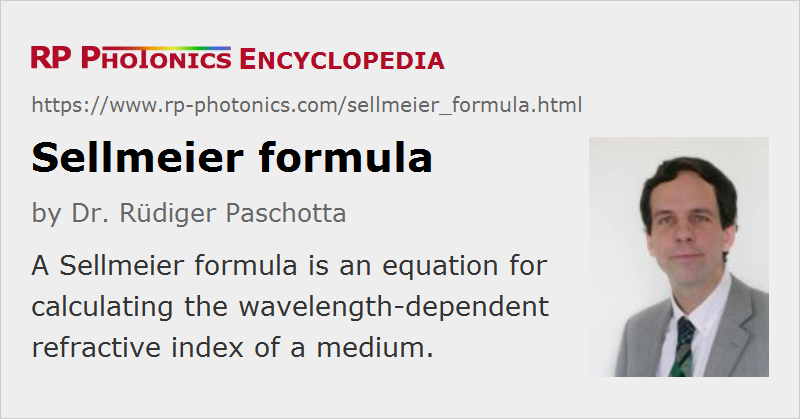Sellmeier Formula
Definition: an equation for calculating the wavelength-dependent refractive index of a medium
German: Sellmeier-Formel
How to cite the article; suggest additional literature
Author: Dr. Rüdiger Paschotta
For the specification of a wavelength-dependent refractive index of a transparent optical material (e.g. an optical glass), it is common to use a so-called Sellmeier formula [1] (also called Sellmeier equation or Sellmeier dispersion formula, after Wolfgang von Sellmeier). This is typically of the form

with the coefficients Aj and Bj. That form results from a relatively simple physical model, which is applicable only to the wavelength region where the absorption is negligible.
As an example, the refractive index of fused silica can be calculated as [2]
where the wavelength in micrometers has to be inserted.
The Sellmeier coefficients are usually obtained by a least-square fitting procedure, applied to refractive indices measured in a wide wavelength range.
Applications
Such equations are very useful, as they make it possible to describe fairly accurately the refractive index in a wide wavelength range with only a few so-called Sellmeier coefficients, which are usually obtained from measured data with some least-square fitting algorithm. Sellmeier coefficients for many optical materials are available in databases. Some caution is advisable when applying Sellmeier equations in extreme wavelength regions; unfortunately, the validity range of available data is often not indicated.
Sellmeier data are also very useful for evaluating the chromatic dispersion of a material. This involves frequency derivatives, which can be performed analytically with Sellmeier data even for high orders of dispersion, whereas numerical differentiation on the basis of tabulated index data is sensitive to noise.
Another frequent application of Sellmeier data is the calculation of phase-matching configurations for nonlinear frequency conversion. Here, it is often critical to have Sellmeier data which are valid in a wide wavelength range.
Modified Equations
The literature contains a great variety of modified equations which are also often called Sellmeier formulas. Extensions to the simple form give above can enlarge the wavelength range of validity, or make it possible to include the temperature dependence of refractive indices. This can be important, for example, for calculating phase-matching configurations for nonlinear frequency conversion.
Alternatives to Sellmeier Equations
There are various other kinds of equations for refractive indices. For example, there is the old Cauchy formula, which is a bit simpler than the Sellmeier formula and still fits the refractive indices of many materials in the visible spectral region quite well, as long as the material has no absorption in the visible region. In the near infrared, however, substantially higher accuracy is achieved with the Sellmeier formula. Other equations have been presented by authors like Schott, Hartmann, Conrady, Kettler–Drude, and Herzberger. For example, the Schott formula is power series for calculating n2.
Questions and Comments from Users
Here you can submit questions and comments. As far as they get accepted by the author, they will appear above this paragraph together with the author’s answer. The author will decide on acceptance based on certain criteria. Essentially, the issue must be of sufficiently broad interest.
Please do not enter personal data here; we would otherwise delete it soon. (See also our privacy declaration.) If you wish to receive personal feedback or consultancy from the author, please contact him e.g. via e-mail.
By submitting the information, you give your consent to the potential publication of your inputs on our website according to our rules. (If you later retract your consent, we will delete those inputs.) As your inputs are first reviewed by the author, they may be published with some delay.
Bibliography
| [1] | W. Sellmeier, Ann. Phys. Chem. 219 (6), 272 (1871), doi:10.1002/andp.18712190612 |
| [2] | I. H. Malitson, “Interspecimen comparison of the refractive index of fused silica”, J. Opt. Soc. Am. 55 (10), 1205 (1965), doi:10.1364/JOSA.55.001205 |
| [3] | G. Ghosh, “Sellmeier coefficients and dispersion of thermo-optic coefficients for some optical glasses”, Appl. Opt. 36 (7), 1540 (1997), doi:10.1364/AO.36.001540 |
| [4] | D. H. Jundt, “Temperature-dependent Sellmeier equation for the index of refraction, ne, in congruent lithium niobate”, Opt. Lett. 22 (20), 1553 (1997), doi:10.1364/OL.22.001553 |
See also: refractive index, dispersion
and other articles in the category general optics
 |





If you like this page, please share the link with your friends and colleagues, e.g. via social media:
These sharing buttons are implemented in a privacy-friendly way!